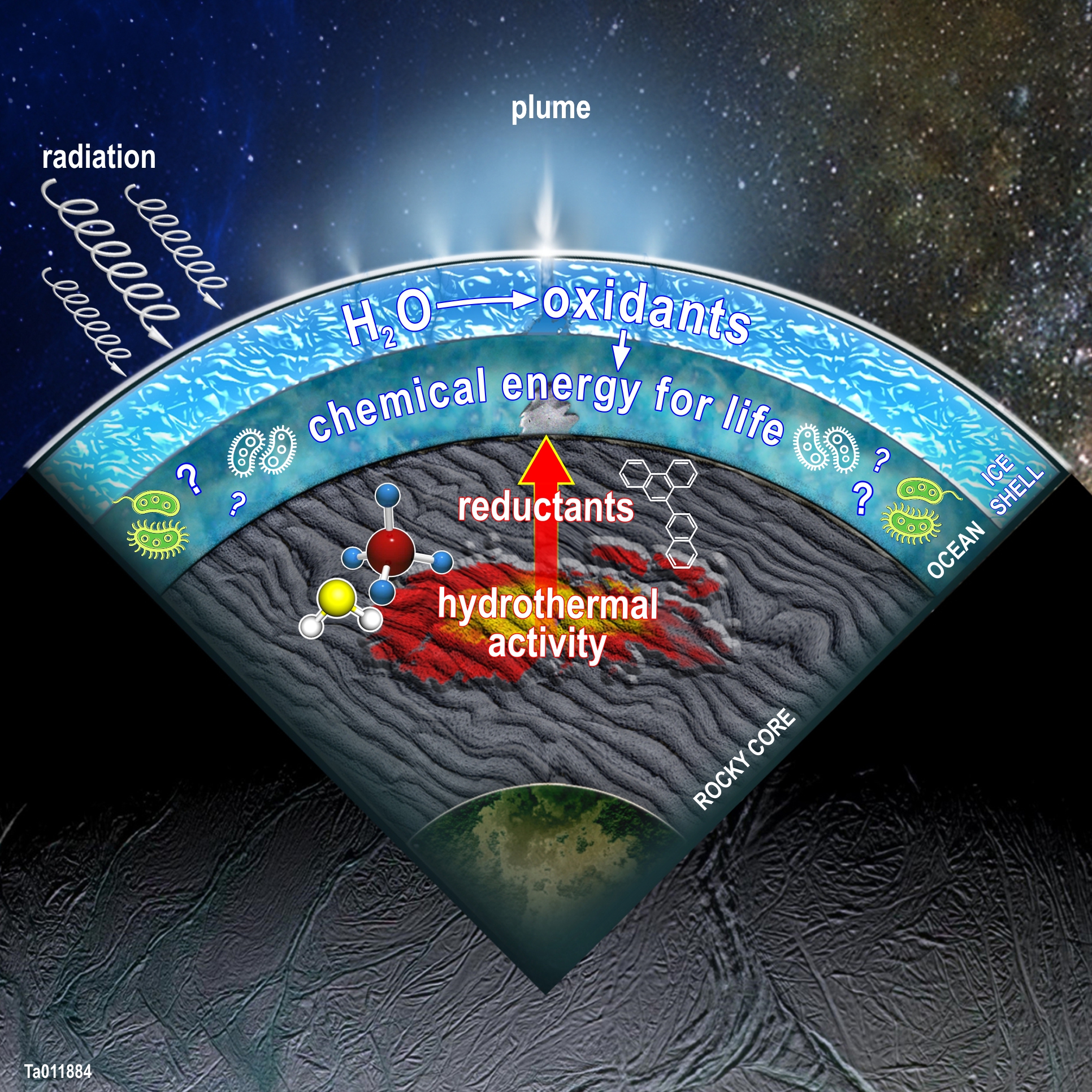Richly covered menu in the Enceladus ocean
Life needs energy for its existence. The more extensive and diverse the supplies of a potential ecosystem are, the more stable the communities that develop there can be. For Saturn’s moon Enceladus, a new study now indicates that a diverse metabolic menu could support a potentially diverse microbial community in the liquid-water ocean beneath the moon’s icy skin.
Using data from NASA’s Cassini spacecraft, scientists at the Southwest Research Institute (SwRI) have modeled the chemical processes in the subsurface ocean of Saturn’s moon Enceladus. Before its deorbit in September 2017, Cassini studied the cloud of ice grains and water vapor emanating from cracks on Enceladus’ icy surface and discovered molecular hydrogen, a potential food source for microbes. A new paper published in the journal Icarus explores other potential energy sources.
“The discovery of molecular hydrogen (H2) in the plume suggests that free energy is available in Enceladus’ ocean,” says lead author Christine Ray of SwRI. “On Earth, aerobic or oxygen-breathing organisms use energy in organic matter such as glucose and oxygen to produce carbon dioxide and water. Anaerobic microbes can metabolize hydrogen to produce methane. All life can be traced to similar chemical reactions involving an imbalance between oxidizing and reducing compounds.”
This imbalance creates a potential energy gradient in which redox chemistry transfers electrons between chemical species, usually oxidizing one species and reducing another. These processes are essential for many basic functions of life, including photosynthesis and respiration. For example, hydrogen is a source of chemical energy that supports anaerobic microbes that live near hydrothermal vents in Earth’s oceans. At the bottom of Earth’s oceans, hydrothermal vents erupt hot, energy-rich, mineral-rich fluids that allow unique ecosystems full of unusual creatures to thrive. Previous research has found increasing evidence of hydrothermal vents and chemical imbalance on Enceladus, suggesting habitable conditions in its subsurface ocean.
“We wondered if other types of metabolic pathways could provide energy sources in Enceladus’ ocean,” Ray says. “Since this would require a different set of oxidants that we have not previously detected in Enceladus’ plume, we performed chemical modeling to determine if conditions in the ocean and rocky core could support these chemical processes.”
For example, the authors examined how ionizing radiation from space might produce the oxidants O2 and H2O2, and how abiotic geochemistry in the ocean and rocky core might contribute to chemical imbalances that could support metabolic processes. The team considered whether these oxidants could accumulate over time if reducing agents were not present in significant quantities. They also considered how aqueous reducing agents or seafloor minerals might convert these oxidants to sulfates and iron oxides.
“We compared our free energy estimates to ecosystems on Earth and found that our values met or exceeded the minimum requirements for both aerobic and anaerobic metabolism overall,” Ray said. “These results suggest that oxidant production and oxidation chemistry could help support possible life and a metabolically diverse microbial community on Enceladus.”
“Now that we have identified potential food sources for microbes, the next question to ask is, ‘what is the nature of the complex organics coming out of the ocean?” said SwRI Program Director Dr. Hunter Waite, a co-author of the new paper. The findings also have major implications for further lunar exploration.
“A future spacecraft could fly through the plume of Enceladus to test the predictions of this paper about the abundance of oxidized compounds in the ocean,” said SwRI Senior Research Scientist Dr. Christopher Glein, another co-author. “We have to be careful, but I think it’s exciting to think about whether there might be strange life forms that take advantage of these energy sources that seem to be fundamental to the way Enceladus works.”
